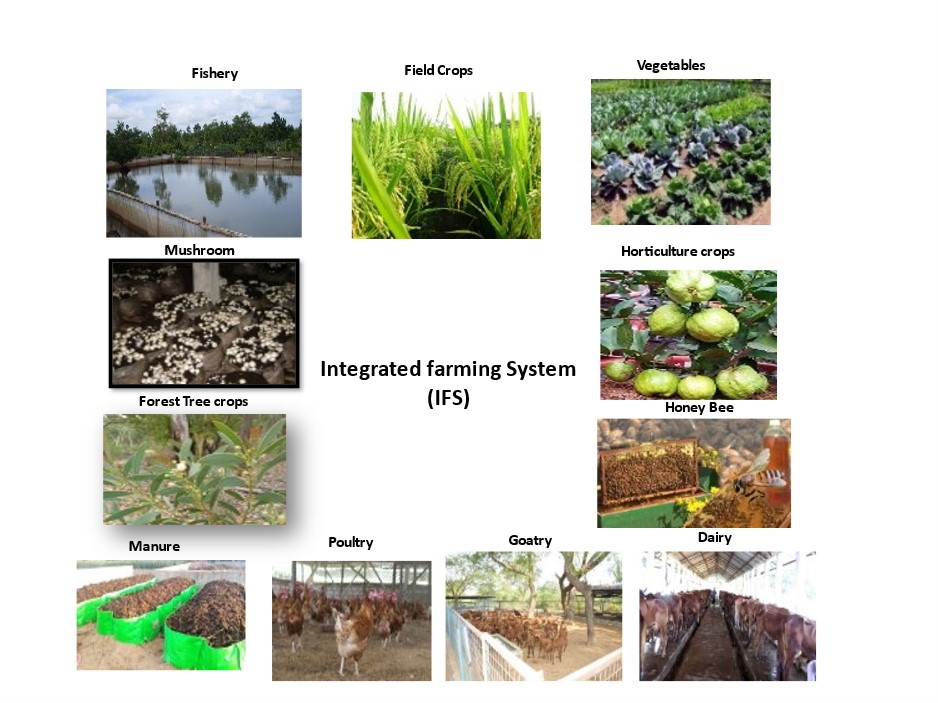Integrated farming system for sustainable agriculture
Integrated farming system for sustainable agriculture
Introduction
Small and marginal farmers are the core of the Indian rural economy constituting 85% of the total farming community. Integrated farming system (IFS) is recognized as a solution to the continuous increase of demand for food production, providing stability to the income and nutritional security particularly for the small and marginal farmers with limited resources.
IFS is a mix of farm enterprises such as crop, livestock, aquaculture, poultry, sericulture and agro-forestry to achieve economic and sustained agricultural production through efficient utilization of resources. The principle of IFS model is developed such as wastes generated from one component becomes an input for other system and hence there is efficient recycling of farm and animal wastes in the integrated system. There is increase in yield per unit area through intensification and diversification of crops. Apart from this IFS helps in controlling insect pests and diseases and weeds through natural cropping system management and there is less use of harmful agro-chemicals for farm production.
IFS development model
The IFS model combines various compatible enterprises such as crops (field crops, horticultural crops), agroforestry (agri-silvi culture, agri-horticulture, agri-pastoral, silvi-pastoral, horti- pastoral), livestock (dairy, pigs, poultry, small ruminants), fishery, mushroom and bee culture in an synergistic way so that the wastes of one process become the input for other processes for optimum farm productivity.
In an IFS model, the field crops are grown for food production. Horticultural and vegetable crops can also provide 2-3 times more energy production than cereal crops and hence ensure nutritional security and income sustainability in the same piece of land. The crop residues after harvesting can be used for animal feed for dairy and goat production. The animal excreta from the animals can also be utilized as organic fertilizer or vermicomposting which in turn improves the soil fertility and thereby, reduces the use of chemical fertilizers. Again, the animal excreta can be dried, composted or liquid composted for the production of biogas and energy for household use.
The rice based integrated farming comprising of rice and fish in the low land area not only improves the fish production but also increases rice yield as fish improve soil fertility by increasing the availability of nitrogen and phosphorous. When the poultry of duck are raised over the ponds, the dropping are utilized by the fishes as nutrients and hence increases their production. Therefore, crop-fish-poultry farming gave the highest net income with an improvement in soil health than single crop farming. By adoption and integration of various components like vegetables and fruit crops, reduce cost of cultivation and provide nutrients to the household. The IFS comprising of crop, dairy, fishery, horticulture and apiary and mushroom culture also provides employment generation throughout the year.
Advantages of IFS
- IFS increases productivity per unit area by virtue of intensification of crops and allied enterprises.
- Integration of different production systems provides an opportunity to solve malnutrition problems in our country.
- It improves soil fertility and soil physical structure from appropriate crop rotation and using cover crops and organic compost. It also minimizes the nutrient losses.
- It reduce weeds, insect pests and diseases through appropriate crop rotation.
- There is higher net returns to land and labour resources of the farming family.
- There is also regular stable income through the products like egg, milk, mushroom, vegetables, honey and silkworm cocoons from the linked activities in integrated farming.
- It reduces production cost of components through input recycling from the by-products of allied enterprises. The recycling of wastes for production helps to avoid piling of wates and consequent pollution.
Conclusion
In a nutshell, an integrated farming system fulfils the multiple objectives of making farmers self-sufficient by ensuring the family members a balance diet, improving the standard of living through maximizing the total net returns and provide more employment, minimizing the risk and uncertainties and keeping harmony with environment. India has the rich diversity of livestock, poultry, crops and horticulture. Utilization of our national resources efficiently is very much important for sustainable development. Thus, this system of farming is very promising for improving overall farm productivity, profitability, generating employment opportunities, conserving natural resources and maintain the sustainability of agroecosystem by effective recycling the farm by-products and efficient utilization of available resources. Integrating Farming System is the unique approach for overall upliftment of rural community and conserving the natural resources and crop diversity.

Figure. IFS model for sustainable agriculture
Content contributors
- Soumya Dash, Scientist, ICAR-National Institute of Biotic Stress Management, Raipur, Chhattisgarh
- Rajalaxmi Behera, Scientist, Regional centre, ICAR-Directorate of Poultry Research, Bhubaneswar, Odisha
- Gayatri Gujar, PhD, Livestock Production management, CVAS, RAJUVAS, Bikaner, Rajasthan
- Rajashree Rath, Teaching Associate, Institute of Para-Veterinary Science, DUVASU, Mathura, Uttar Pradesh
Last Modified : 8/11/2023
This topic provides information about Empowerment ...
Fish based Integrated Farming Systems adopted in A...
COVID-19 Mitigation Advisory for Fish Transportati...
Provides links to all institutes and State Agricul...
